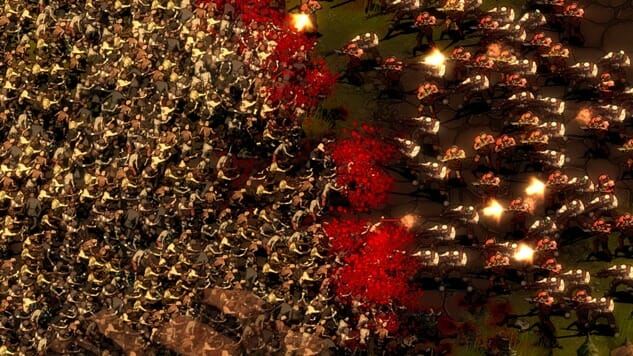They Are Billions in its current incarnation does little in the way of history-building. The world is as it is on first launch, consumed by the ever-present hordes of zombies that roam the earth’s surface in a state of constant hunger. It is, most importantly, empty: completely stripped of human inhabitants. The setting pits steampunk colonists against the ravenous horde, each side with a single-minded goal to maintain a foothold on the land itself.
Each level of They Are Billions begins the same. You have five small military units and one command center, placed randomly on a procedurally generated map. There is one defined goal in the game: to survive. There is a secondary goal that becomes immediately clear in the first few moments. Survival comes with security, and security requires land.
The game swiftly teaches a player that maintaining dominance over physical land is one of the most powerful tools at your disposal. Forests and stone veins may allow for resource acquisition, yes, but they must first be added to the power grid (extended by Tesla Towers from the initial command center) and then developed on by a resource-gathering building.
These buildings require colonists to staff them, so a diligent player will place down colonist dwellings in whatever spaces they can, to acquire enough colonists in order to staff the next resource-gathering building. The building then generates a trackable resource on a set timer. But there’s a threat—a zombie horde uncomfortably close to the north. A wall is necessary. But walls require wood, so a sawmill is necessary, so more colonists are necessary—and so on.
The underpinning of all of these mechanics is the tension of being underequipped in a strange land. The colonizing force that players control is, more often than not, overwhelmed by the horde at the end of a game. The colonizer is removed by force.
They Are Billions, either consciously or subconsciously, recalls the most basic of steampunk influences, the Victorian Era of England. To be sure, there are also zombies, and robots, and a few pieces of anachronistic technology and weaponry, but the game sticks not just to the look of Victorian England, but the attitudes. Chief among them, of course: colonialism.
Steampunk has never been exactly “neat.” The influences that make up the subgenre/subculture range from Victorian England to art nouveau to Orientalist art, with plenty more sources peppered between. It’s relatively young, named in the 1980s and never quite fitting with any defined ideological bent. The genre seems defined chiefly by aesthetic and very little else—gears and top hats and brass and, of course, steam.
The mid-1800s saw England at the height of its colonial power. By the time of the swearing-in of Queen Victoria in 1837, the British Empire had active colonies on practically every continent on the planet. Industrialization was entering the economic purview of the country. It was a time of plenty for those lucky enough to be born in the right place with the right skin color, and a reign of expansionary conflict for most of the colonies.
Making a one-to-one analogy between any fantasy creature and a real-world counterpart is, at best, clumsy, and at worst offensive, and that’s not exactly what I want to draw here. But They Are Billions does fall into a number of colonialist tropes that are rooted in its aesthetic inspirations. The wilderness is to be conquered, and civilization bursts forth from empire.
As I made my way through the wilds of the game, I found myself thinking how bizarre it is that my faction of steampunk crusaders had any reason to be staking a foothold here. There is a loose, possible thread of canon that this was your homeland, taken over by zombies, but most of the maps don’t reflect this. There are sparse indicators of former homes and factories, but by and large the world is just zombies.
All the while, I am thinking less of the land as a place and more as a resource. Real-time-strategy games are no stranger to seeing physical land as a checklist of extractable material, They Are Billions simply accelerates and intensifies the standard RTS game flow. The constant threat from the outside means that expansions must focus on security first and foremost. The game’s simple trick of making each colonizer unit capable of turning on their own faction after being bitten means that walls, or at least roving soldiers, are a quintessential part of expansion efforts. Areas must be swept of undead presence before establishing power grids or settlements.
Every venturing-forth for more land becomes more desperate. My own small empire becomes more and more packed and complex, ever more susceptible to a single crack in the armor.
And when the final walls do fall—and they do, often—I cannot help but think there is a relief in that. The tension breaks, and the horde consumes all I have made. All my buildings return to the populous heirs of the planet, as the zombies multiply into my sanctum like the tide coming back in. They kind of deserve it, I think. After all, they seem to be far more suited for this land than I am.
Dante Douglas is a writer, poet and game developer. You can find him on Twitter at @videodante.
